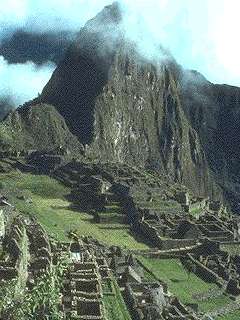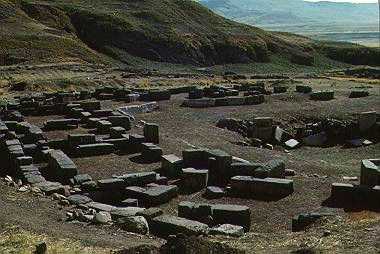

There isn't anything quite as chilling as a city bereft of its inhabitants. A silent array of towers, walls and houses, without voices or the scatterings of everyday life. A place solely constructed to shelter people, that now has no purpose. Abandoned cities can be found all over the world. Some were wiped out by war, while others starved in famine or died of disease. In the case of the most ancient cities, the mysteries of their deaths may never be solved.
Hiring a guide, Bingham set off in a cold drizzle through a forest and up a long slope. In the steepest sections logs with notches cut in them served as ladders. Any fall would have been fatal.
After a two hour climb, Bingham finally was led to a fantastic sight: perched between two peaks was a city. Bingham was able to find the ruins of many houses, a staircase, fountains, and a temple with an altar for the Sun God.
The city is now known as Machu Picchu. At first Bingham supposed this had been built as a hideout from the Spanish that invaded Inca territories in 1532. Archaeological investigations, though, have established the city was built before the Spanish arrived. The first signs of human habitation date back to 1300 A.D. The city was fortified and probably used for religious ceremonies. The Spanish invaders never found this sacred place and the Incas secret was safe on top of the mountain.
Despite this, the Mayans never seemed to move beyond the stone age. They never employed the wheel for any practical purpose, nor developed a phonetic alphabet. Despite amazing feats of architecture, including a suspension bridge 600 feet in length, they never figured out how to build a "true" arch.
This paradox, the Mayan's genius in the theoretical, with little practical application, has led some to suggest their knowledge came as the result of visits from ancient alien astronauts. Others think that the Mayans may have had an unprecedented genius in their history who single-handedly moved their science forward in a great leap.
The Mayans also built wonderful cities with large pyramids, terraces and temples made of stone. From 300 to 800 A.D. these city-states thrived and many vast complexes of public buildings were erected. These dozen or so metropolises became bustling centers of commerce and culture. None had walls or fortifications. The Mayans, isolated from the outside world, lived with themselves in perfect peace.
Then suddenly the Mayans abandoned their cities and migrated to the edge of their empire traveling north to the Yucatan. Their great cities, left to the forest, soon crumbled and vanished only to be discovered by the Spanish hundreds of years later. Why did the Mayans abandon their great metropolises? Did it just become too hard to farm in the jungle? Did centuries of burning and planting exhaust the soil? Or did the common people rebel against a harsh ruling class sending them to live at the outskirts of civilization only to discover the lower classes were incapable of maintaining the cities alone? Why move north when that brought them into contact with other nations which led to war? We may never know. Mayan books that may have contained this secret were burned by the Spanish who feared them as "works of the Devil."

The Palace in the Cliff
Mesa Verde means "Green Table" in Spanish and it is an appropriate name. This part of Colorado is a flat tableland some 20 miles long and 18 miles wide. The top is some 2,000 feet higher than the surrounding land. To the south the Mesa is cut by some 20 canyons which contain over 500 hundred Indian ruins, of which Cliff Palace is the largest.
Archaeologists estimate that the native Americans who built Cliff Palace arrived in Mesa Verde as early as 1 A.D. They apparently lived a quiet and peaceful life on the Mesa tops until about 1200 A.D. when suddenly they abandoned their towns and built new ones in caves on the cliff faces. Why? Probably for security. The caves were large (the cave at Cliff Palace is one-hundred feet deep and three-hundred feet wide) and gave protection from the sun, rain, snow and human enemies.
Cliff Palace has over two-hundred rooms and some parts are three stories high. It probably housed around 400 people. Though the residents lived in the cave, they commuted to the Mesa top to work their agricultural fields.
Around 1280, though, the Indians suddenly abandoned their cliff dwellings and moved away. There is no sign that they were forced out by war, so what could have made the residents leave their new cities barely 80 years after they had been built?
In this case scientists think they have found the answer in the trees of the Mesa. When a tree is cut down, the cross section shows a series of concentric rings. One new ring is laid down each year. By counting the rings it is possible to tell the age of the tree. By looking at the width of the ring it is possible to tell how much a tree grew in any particular year.
By examining trees, scientists have been able to determine that a severe drought hit the Mesa around 1276 and lasted 24 years. This affected the residents food supply and they were forced to move. They apparently went south and mixed with the Pueblo Indians that live there even to this day. Many items were still in the rooms at Cliff Palace and it is likely that the residents intended to return at the end of the drought. They never came back, though, and all that is left of their culture is the silent cities in the Mesa Verde cliffs.

The City of the White Men There isn't much left of the city of Tiahuanaco in Peru. In the 1500's, the Spanish systematically destroyed the buildings. Later, many of the stone blocks were looted for houses in a nearby village. Most recently more stone was taken to lay a railroad right-of-way.
Despite this, what is left is still a sight to see. Tiahuanaco is old. It was already in ruins when the Incas took over the area in 1200 A.D.. It is situated on a mountain at an altitude of 12,500 feet and boasts a pyramid 700 feet long, 500 feet wide and 50 feet tall. There is also a temple 440 feet long topped with columns up to 14 feet high that may have once supported a roof.
The most impressive thing about Tiahuanaco isn't its architecture, though. It's the legend about who built it. According to traditions the city was constructed by a group of white skinned-strangers with beards. The leader was named Viracocha. According to an early European explorer ,it was said that Viracocha, "gave rules to men how they should live, and he spoke lovingly to them with much kindness, admonishing them they should be kind to each other..."
There are similar stories about visits by a bearded white man among the Aztec and Mayans. He was called Quetzalcoatl by the Aztecs and Kukulcan by the Mayans. How did white men arrive in Peru long before the Spanish did? Archaeologists estimate the city was founded around 200 A.D. If the legends are true, who are these people? Some have suggested that the Egyptians, Cretans, Greeks, Phoenicians or even Irish monks may have crossed the Atlantic to visit South America. The explorer Thor Heyerdahl even built a boat of reeds and sailed it across the ocean to prove the Egyptians could have made such a voyage.
There is no solid evidence to prove any of these theories, so who these
white men were and why they built Tiahuanaco may remain a mystery that
may never be solved.